Leadership and Management in Contemporary Business Operations
VerifiedAdded on 2024/05/21
|18
|6137
|434
Report
AI Summary
This report elucidates the distinct roles of leaders and managers within an organization, emphasizing their importance in ensuring operational efficiency. It defines and compares the characteristics of leaders and managers, highlighting their responsibilities and functions, particularly within a retail context like Sainsbury's. The report applies various leadership and management theories, including contingency, situational, and system leadership, to analyze real-world scenarios. It evaluates the strengths and weaknesses of these approaches and explores how leaders and managers can enhance operational management to achieve business objectives. Furthermore, the report assesses the impact of economic, social, and technological factors on operational management and decision-making, providing a comprehensive understanding of the relationship between leadership and management in contemporary business environments. This assignment solution is available on Desklib, a platform providing study tools for students.
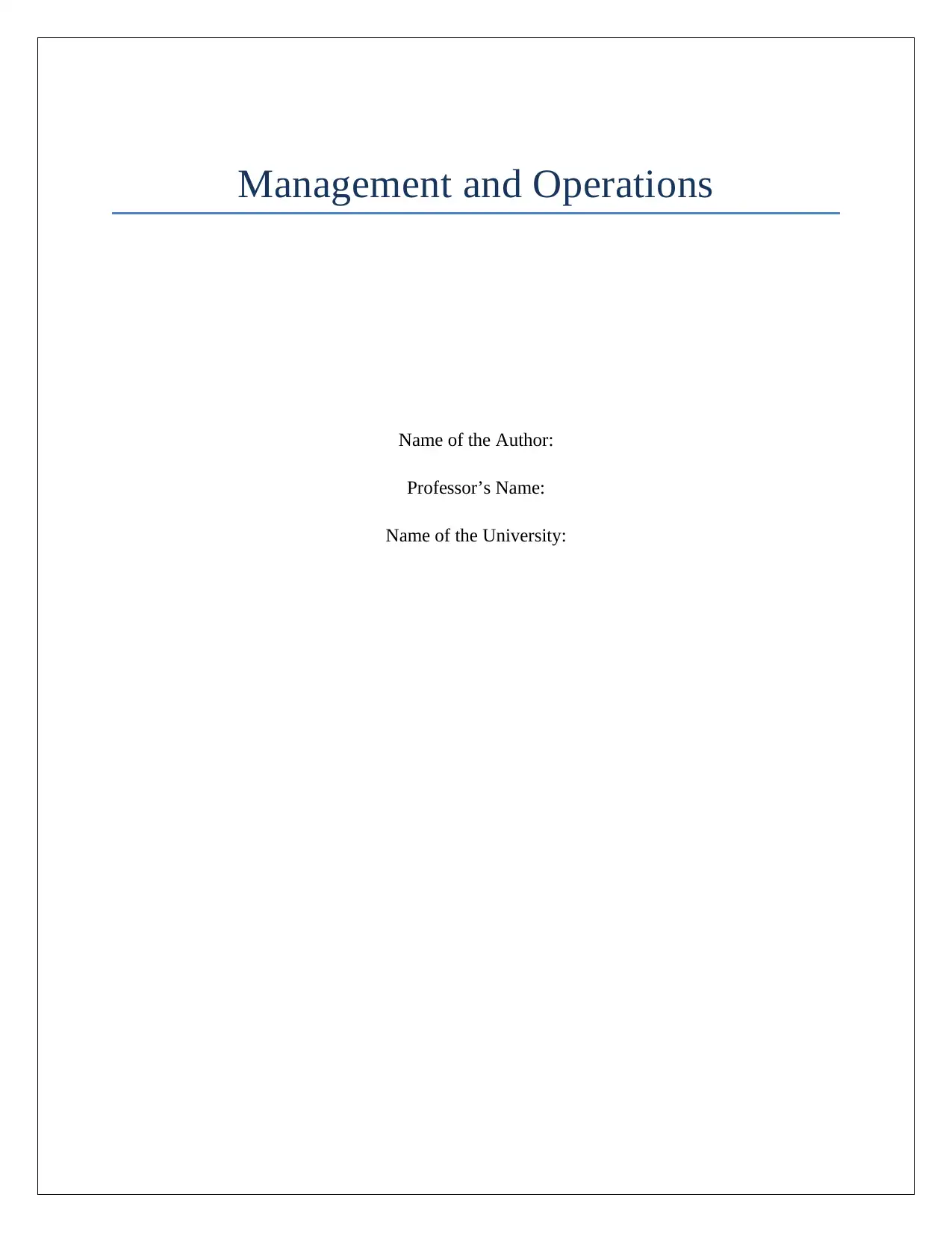
Management and Operations
Name of the Author:
Professor’s Name:
Name of the University:
Name of the Author:
Professor’s Name:
Name of the University:
Paraphrase This Document
Need a fresh take? Get an instant paraphrase of this document with our AI Paraphraser
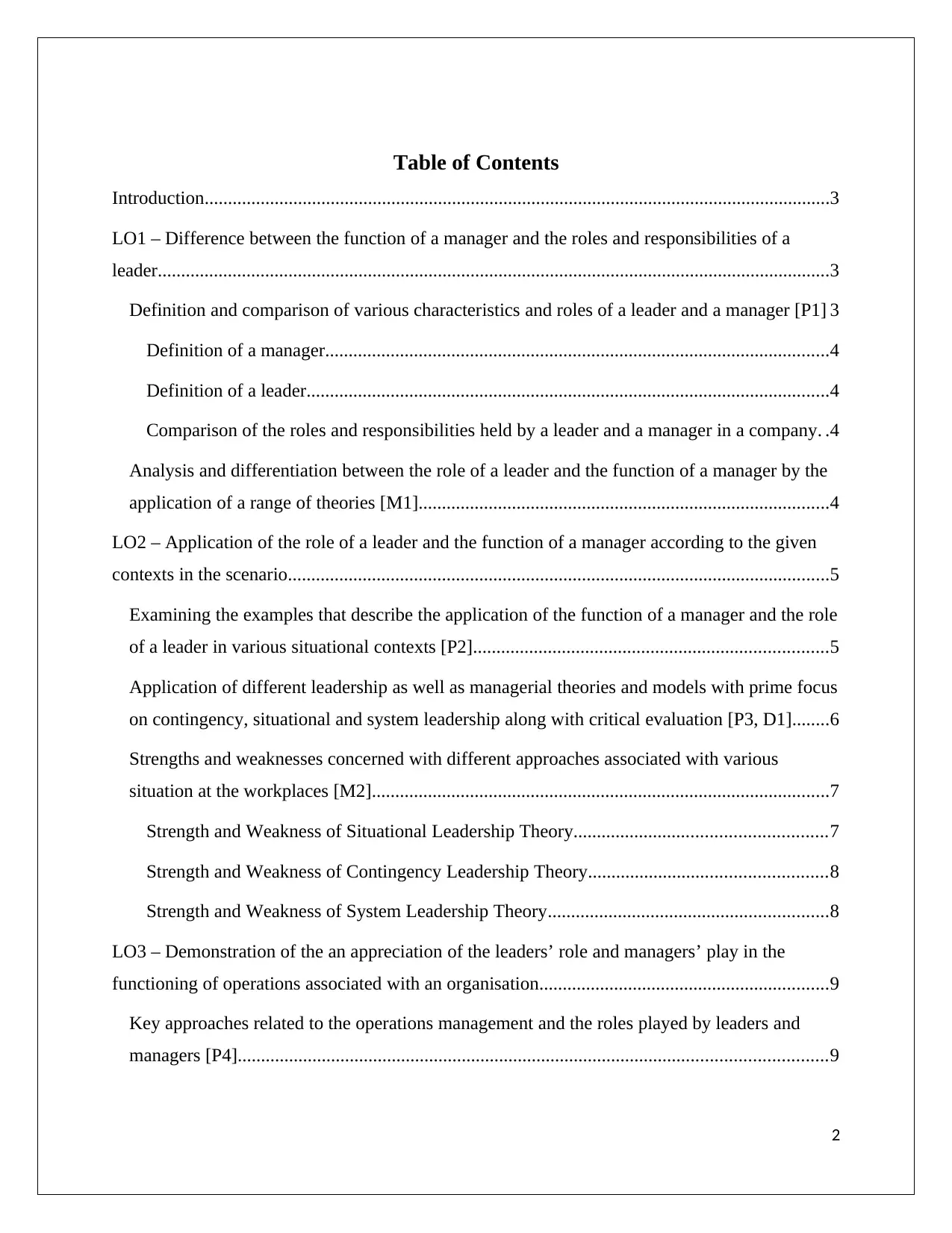
Table of Contents
Introduction......................................................................................................................................3
LO1 – Difference between the function of a manager and the roles and responsibilities of a
leader................................................................................................................................................3
Definition and comparison of various characteristics and roles of a leader and a manager [P1] 3
Definition of a manager............................................................................................................4
Definition of a leader................................................................................................................4
Comparison of the roles and responsibilities held by a leader and a manager in a company. .4
Analysis and differentiation between the role of a leader and the function of a manager by the
application of a range of theories [M1]........................................................................................4
LO2 – Application of the role of a leader and the function of a manager according to the given
contexts in the scenario....................................................................................................................5
Examining the examples that describe the application of the function of a manager and the role
of a leader in various situational contexts [P2]............................................................................5
Application of different leadership as well as managerial theories and models with prime focus
on contingency, situational and system leadership along with critical evaluation [P3, D1]........6
Strengths and weaknesses concerned with different approaches associated with various
situation at the workplaces [M2]..................................................................................................7
Strength and Weakness of Situational Leadership Theory......................................................7
Strength and Weakness of Contingency Leadership Theory...................................................8
Strength and Weakness of System Leadership Theory............................................................8
LO3 – Demonstration of the an appreciation of the leaders’ role and managers’ play in the
functioning of operations associated with an organisation..............................................................9
Key approaches related to the operations management and the roles played by leaders and
managers [P4]..............................................................................................................................9
2
Introduction......................................................................................................................................3
LO1 – Difference between the function of a manager and the roles and responsibilities of a
leader................................................................................................................................................3
Definition and comparison of various characteristics and roles of a leader and a manager [P1] 3
Definition of a manager............................................................................................................4
Definition of a leader................................................................................................................4
Comparison of the roles and responsibilities held by a leader and a manager in a company. .4
Analysis and differentiation between the role of a leader and the function of a manager by the
application of a range of theories [M1]........................................................................................4
LO2 – Application of the role of a leader and the function of a manager according to the given
contexts in the scenario....................................................................................................................5
Examining the examples that describe the application of the function of a manager and the role
of a leader in various situational contexts [P2]............................................................................5
Application of different leadership as well as managerial theories and models with prime focus
on contingency, situational and system leadership along with critical evaluation [P3, D1]........6
Strengths and weaknesses concerned with different approaches associated with various
situation at the workplaces [M2]..................................................................................................7
Strength and Weakness of Situational Leadership Theory......................................................7
Strength and Weakness of Contingency Leadership Theory...................................................8
Strength and Weakness of System Leadership Theory............................................................8
LO3 – Demonstration of the an appreciation of the leaders’ role and managers’ play in the
functioning of operations associated with an organisation..............................................................9
Key approaches related to the operations management and the roles played by leaders and
managers [P4]..............................................................................................................................9
2
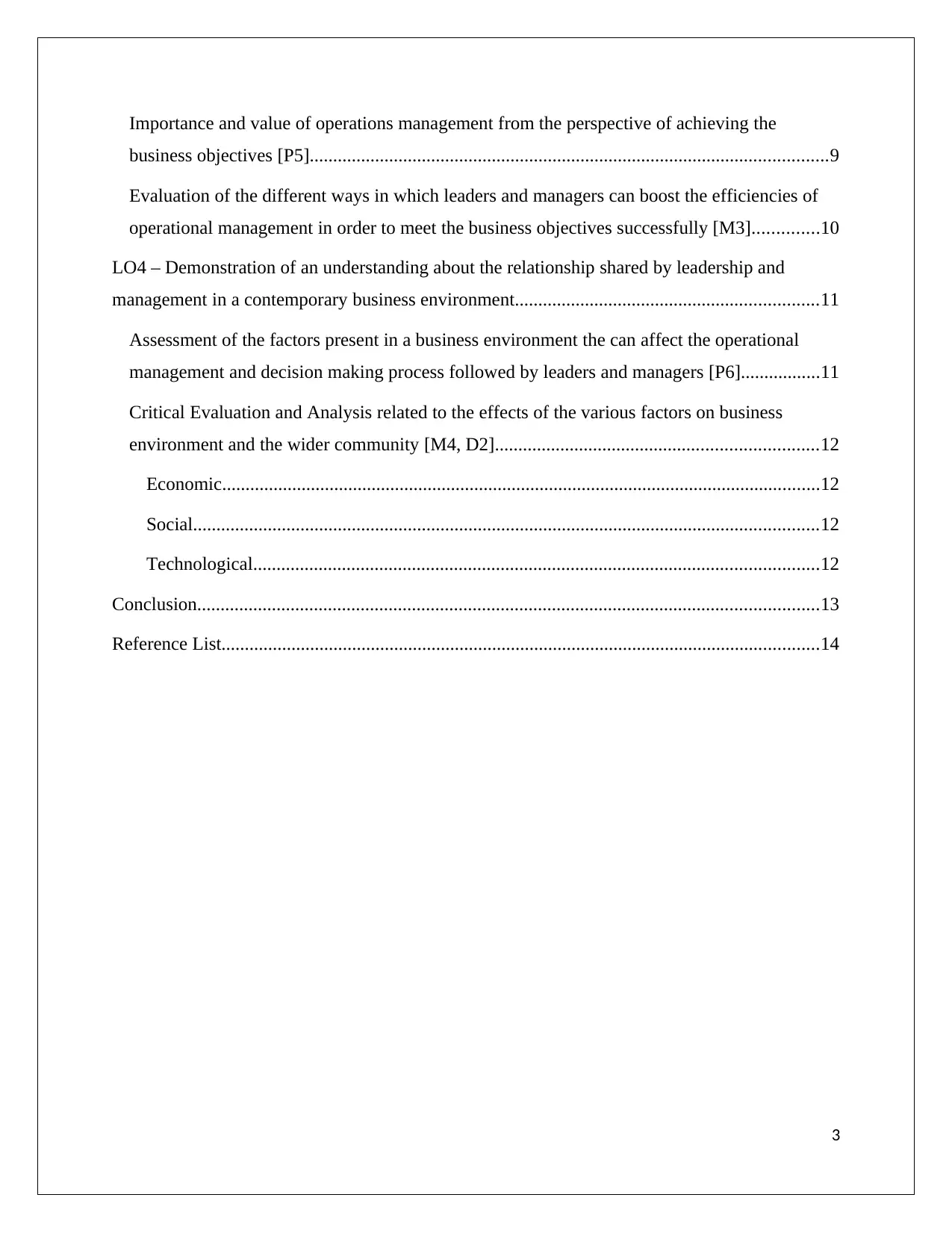
Importance and value of operations management from the perspective of achieving the
business objectives [P5]...............................................................................................................9
Evaluation of the different ways in which leaders and managers can boost the efficiencies of
operational management in order to meet the business objectives successfully [M3]..............10
LO4 – Demonstration of an understanding about the relationship shared by leadership and
management in a contemporary business environment.................................................................11
Assessment of the factors present in a business environment the can affect the operational
management and decision making process followed by leaders and managers [P6].................11
Critical Evaluation and Analysis related to the effects of the various factors on business
environment and the wider community [M4, D2].....................................................................12
Economic................................................................................................................................12
Social......................................................................................................................................12
Technological.........................................................................................................................12
Conclusion.....................................................................................................................................13
Reference List................................................................................................................................14
3
business objectives [P5]...............................................................................................................9
Evaluation of the different ways in which leaders and managers can boost the efficiencies of
operational management in order to meet the business objectives successfully [M3]..............10
LO4 – Demonstration of an understanding about the relationship shared by leadership and
management in a contemporary business environment.................................................................11
Assessment of the factors present in a business environment the can affect the operational
management and decision making process followed by leaders and managers [P6].................11
Critical Evaluation and Analysis related to the effects of the various factors on business
environment and the wider community [M4, D2].....................................................................12
Economic................................................................................................................................12
Social......................................................................................................................................12
Technological.........................................................................................................................12
Conclusion.....................................................................................................................................13
Reference List................................................................................................................................14
3
⊘ This is a preview!⊘
Do you want full access?
Subscribe today to unlock all pages.

Trusted by 1+ million students worldwide
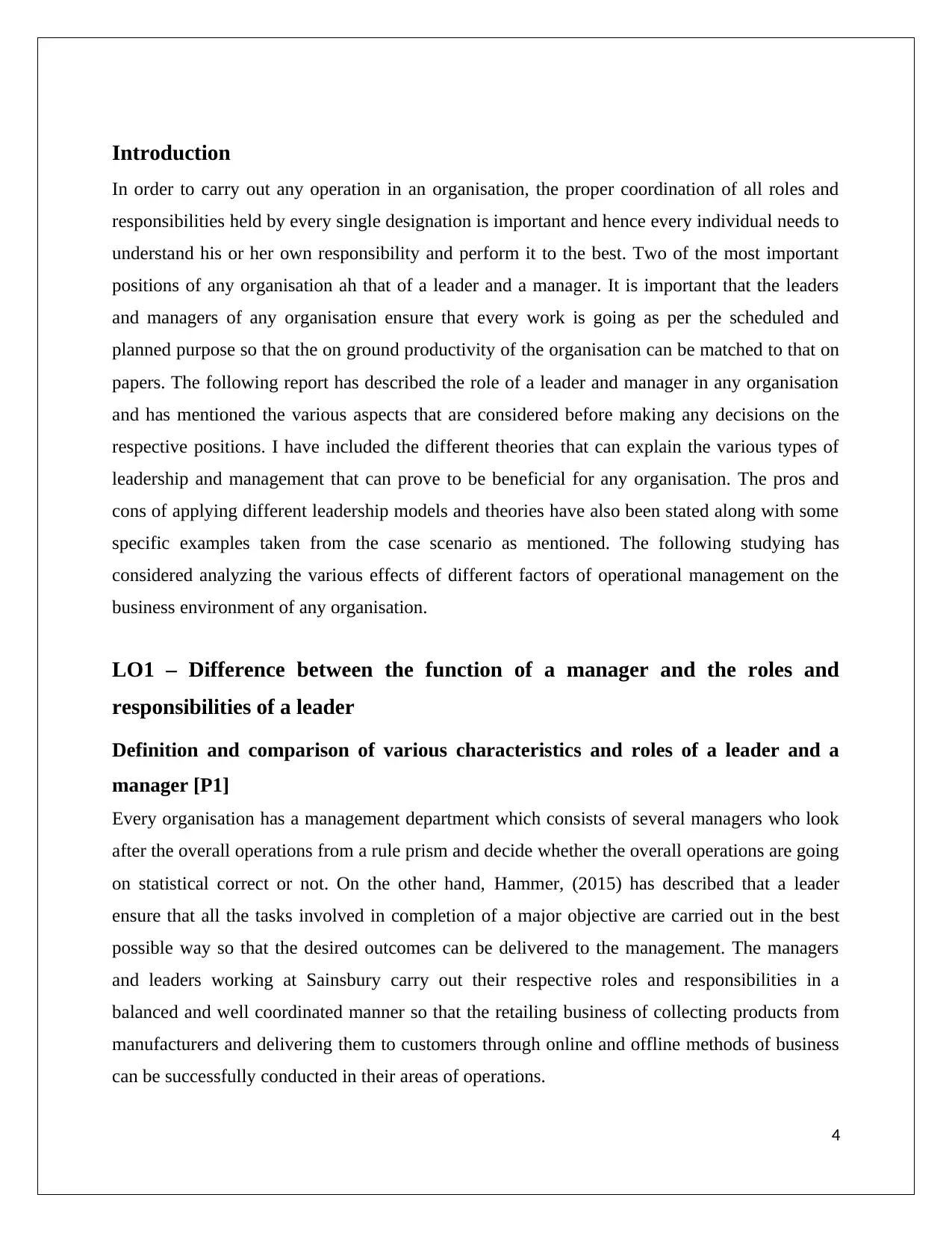
Introduction
In order to carry out any operation in an organisation, the proper coordination of all roles and
responsibilities held by every single designation is important and hence every individual needs to
understand his or her own responsibility and perform it to the best. Two of the most important
positions of any organisation ah that of a leader and a manager. It is important that the leaders
and managers of any organisation ensure that every work is going as per the scheduled and
planned purpose so that the on ground productivity of the organisation can be matched to that on
papers. The following report has described the role of a leader and manager in any organisation
and has mentioned the various aspects that are considered before making any decisions on the
respective positions. I have included the different theories that can explain the various types of
leadership and management that can prove to be beneficial for any organisation. The pros and
cons of applying different leadership models and theories have also been stated along with some
specific examples taken from the case scenario as mentioned. The following studying has
considered analyzing the various effects of different factors of operational management on the
business environment of any organisation.
LO1 – Difference between the function of a manager and the roles and
responsibilities of a leader
Definition and comparison of various characteristics and roles of a leader and a
manager [P1]
Every organisation has a management department which consists of several managers who look
after the overall operations from a rule prism and decide whether the overall operations are going
on statistical correct or not. On the other hand, Hammer, (2015) has described that a leader
ensure that all the tasks involved in completion of a major objective are carried out in the best
possible way so that the desired outcomes can be delivered to the management. The managers
and leaders working at Sainsbury carry out their respective roles and responsibilities in a
balanced and well coordinated manner so that the retailing business of collecting products from
manufacturers and delivering them to customers through online and offline methods of business
can be successfully conducted in their areas of operations.
4
In order to carry out any operation in an organisation, the proper coordination of all roles and
responsibilities held by every single designation is important and hence every individual needs to
understand his or her own responsibility and perform it to the best. Two of the most important
positions of any organisation ah that of a leader and a manager. It is important that the leaders
and managers of any organisation ensure that every work is going as per the scheduled and
planned purpose so that the on ground productivity of the organisation can be matched to that on
papers. The following report has described the role of a leader and manager in any organisation
and has mentioned the various aspects that are considered before making any decisions on the
respective positions. I have included the different theories that can explain the various types of
leadership and management that can prove to be beneficial for any organisation. The pros and
cons of applying different leadership models and theories have also been stated along with some
specific examples taken from the case scenario as mentioned. The following studying has
considered analyzing the various effects of different factors of operational management on the
business environment of any organisation.
LO1 – Difference between the function of a manager and the roles and
responsibilities of a leader
Definition and comparison of various characteristics and roles of a leader and a
manager [P1]
Every organisation has a management department which consists of several managers who look
after the overall operations from a rule prism and decide whether the overall operations are going
on statistical correct or not. On the other hand, Hammer, (2015) has described that a leader
ensure that all the tasks involved in completion of a major objective are carried out in the best
possible way so that the desired outcomes can be delivered to the management. The managers
and leaders working at Sainsbury carry out their respective roles and responsibilities in a
balanced and well coordinated manner so that the retailing business of collecting products from
manufacturers and delivering them to customers through online and offline methods of business
can be successfully conducted in their areas of operations.
4
Paraphrase This Document
Need a fresh take? Get an instant paraphrase of this document with our AI Paraphraser
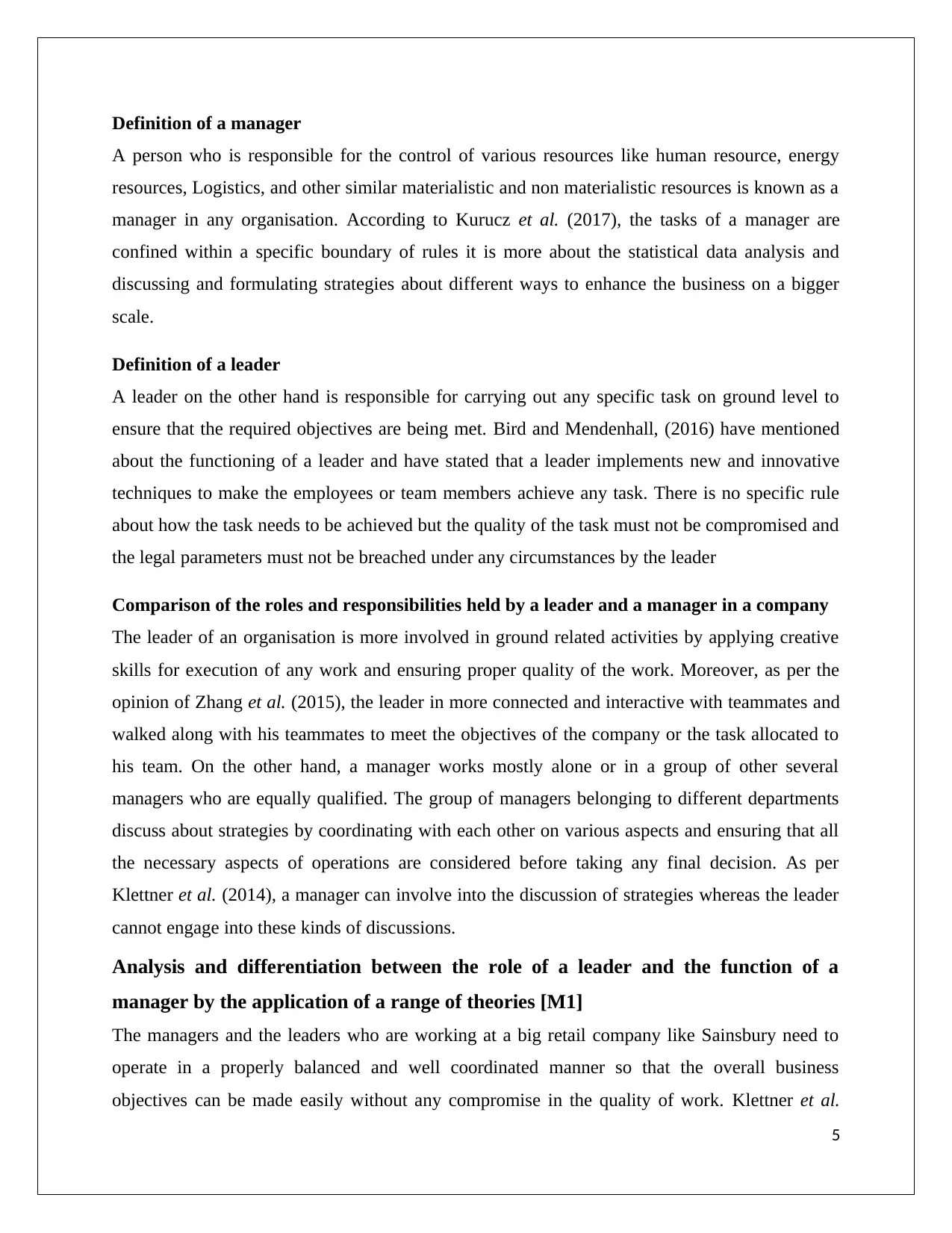
Definition of a manager
A person who is responsible for the control of various resources like human resource, energy
resources, Logistics, and other similar materialistic and non materialistic resources is known as a
manager in any organisation. According to Kurucz et al. (2017), the tasks of a manager are
confined within a specific boundary of rules it is more about the statistical data analysis and
discussing and formulating strategies about different ways to enhance the business on a bigger
scale.
Definition of a leader
A leader on the other hand is responsible for carrying out any specific task on ground level to
ensure that the required objectives are being met. Bird and Mendenhall, (2016) have mentioned
about the functioning of a leader and have stated that a leader implements new and innovative
techniques to make the employees or team members achieve any task. There is no specific rule
about how the task needs to be achieved but the quality of the task must not be compromised and
the legal parameters must not be breached under any circumstances by the leader
Comparison of the roles and responsibilities held by a leader and a manager in a company
The leader of an organisation is more involved in ground related activities by applying creative
skills for execution of any work and ensuring proper quality of the work. Moreover, as per the
opinion of Zhang et al. (2015), the leader in more connected and interactive with teammates and
walked along with his teammates to meet the objectives of the company or the task allocated to
his team. On the other hand, a manager works mostly alone or in a group of other several
managers who are equally qualified. The group of managers belonging to different departments
discuss about strategies by coordinating with each other on various aspects and ensuring that all
the necessary aspects of operations are considered before taking any final decision. As per
Klettner et al. (2014), a manager can involve into the discussion of strategies whereas the leader
cannot engage into these kinds of discussions.
Analysis and differentiation between the role of a leader and the function of a
manager by the application of a range of theories [M1]
The managers and the leaders who are working at a big retail company like Sainsbury need to
operate in a properly balanced and well coordinated manner so that the overall business
objectives can be made easily without any compromise in the quality of work. Klettner et al.
5
A person who is responsible for the control of various resources like human resource, energy
resources, Logistics, and other similar materialistic and non materialistic resources is known as a
manager in any organisation. According to Kurucz et al. (2017), the tasks of a manager are
confined within a specific boundary of rules it is more about the statistical data analysis and
discussing and formulating strategies about different ways to enhance the business on a bigger
scale.
Definition of a leader
A leader on the other hand is responsible for carrying out any specific task on ground level to
ensure that the required objectives are being met. Bird and Mendenhall, (2016) have mentioned
about the functioning of a leader and have stated that a leader implements new and innovative
techniques to make the employees or team members achieve any task. There is no specific rule
about how the task needs to be achieved but the quality of the task must not be compromised and
the legal parameters must not be breached under any circumstances by the leader
Comparison of the roles and responsibilities held by a leader and a manager in a company
The leader of an organisation is more involved in ground related activities by applying creative
skills for execution of any work and ensuring proper quality of the work. Moreover, as per the
opinion of Zhang et al. (2015), the leader in more connected and interactive with teammates and
walked along with his teammates to meet the objectives of the company or the task allocated to
his team. On the other hand, a manager works mostly alone or in a group of other several
managers who are equally qualified. The group of managers belonging to different departments
discuss about strategies by coordinating with each other on various aspects and ensuring that all
the necessary aspects of operations are considered before taking any final decision. As per
Klettner et al. (2014), a manager can involve into the discussion of strategies whereas the leader
cannot engage into these kinds of discussions.
Analysis and differentiation between the role of a leader and the function of a
manager by the application of a range of theories [M1]
The managers and the leaders who are working at a big retail company like Sainsbury need to
operate in a properly balanced and well coordinated manner so that the overall business
objectives can be made easily without any compromise in the quality of work. Klettner et al.
5
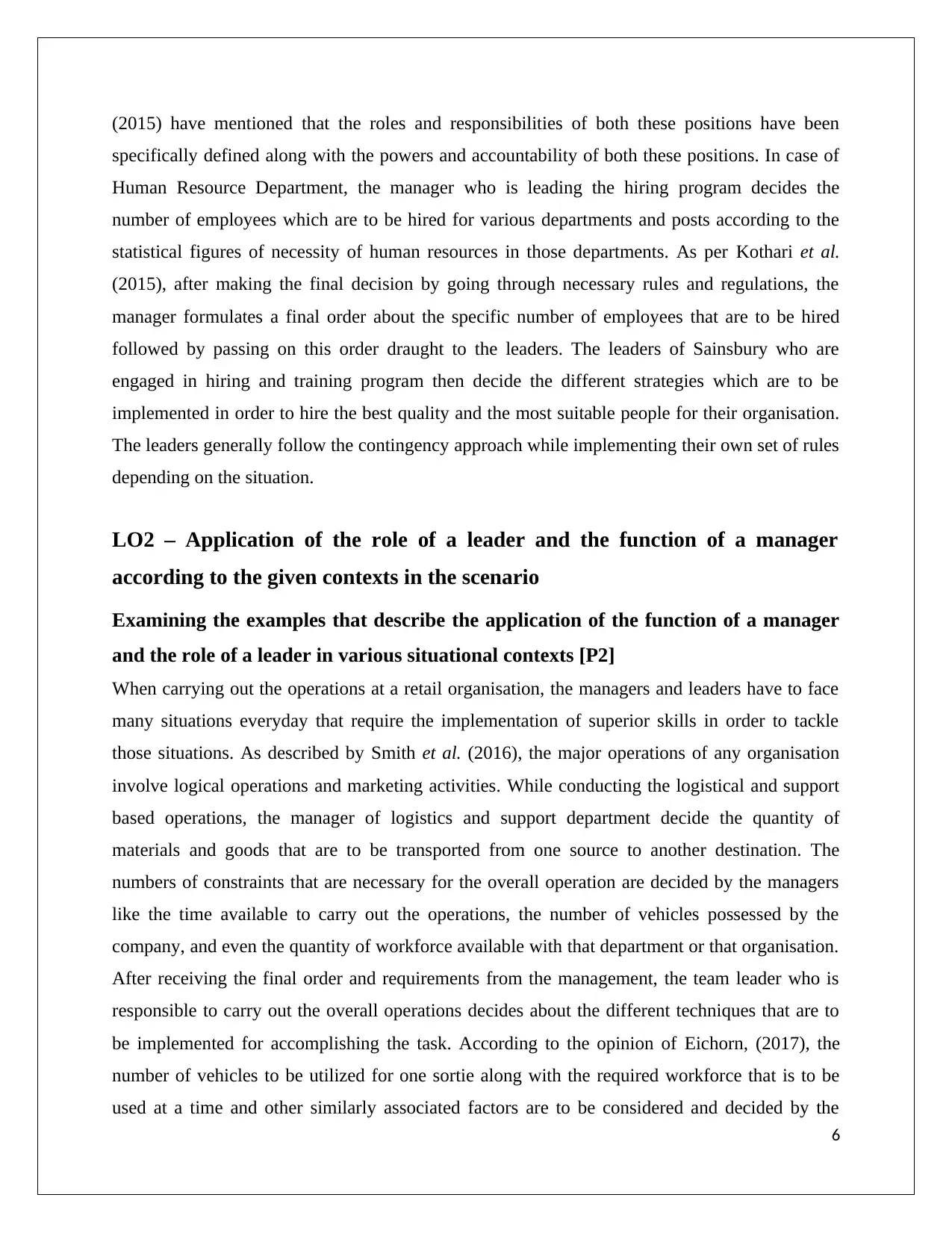
(2015) have mentioned that the roles and responsibilities of both these positions have been
specifically defined along with the powers and accountability of both these positions. In case of
Human Resource Department, the manager who is leading the hiring program decides the
number of employees which are to be hired for various departments and posts according to the
statistical figures of necessity of human resources in those departments. As per Kothari et al.
(2015), after making the final decision by going through necessary rules and regulations, the
manager formulates a final order about the specific number of employees that are to be hired
followed by passing on this order draught to the leaders. The leaders of Sainsbury who are
engaged in hiring and training program then decide the different strategies which are to be
implemented in order to hire the best quality and the most suitable people for their organisation.
The leaders generally follow the contingency approach while implementing their own set of rules
depending on the situation.
LO2 – Application of the role of a leader and the function of a manager
according to the given contexts in the scenario
Examining the examples that describe the application of the function of a manager
and the role of a leader in various situational contexts [P2]
When carrying out the operations at a retail organisation, the managers and leaders have to face
many situations everyday that require the implementation of superior skills in order to tackle
those situations. As described by Smith et al. (2016), the major operations of any organisation
involve logical operations and marketing activities. While conducting the logistical and support
based operations, the manager of logistics and support department decide the quantity of
materials and goods that are to be transported from one source to another destination. The
numbers of constraints that are necessary for the overall operation are decided by the managers
like the time available to carry out the operations, the number of vehicles possessed by the
company, and even the quantity of workforce available with that department or that organisation.
After receiving the final order and requirements from the management, the team leader who is
responsible to carry out the overall operations decides about the different techniques that are to
be implemented for accomplishing the task. According to the opinion of Eichorn, (2017), the
number of vehicles to be utilized for one sortie along with the required workforce that is to be
used at a time and other similarly associated factors are to be considered and decided by the
6
specifically defined along with the powers and accountability of both these positions. In case of
Human Resource Department, the manager who is leading the hiring program decides the
number of employees which are to be hired for various departments and posts according to the
statistical figures of necessity of human resources in those departments. As per Kothari et al.
(2015), after making the final decision by going through necessary rules and regulations, the
manager formulates a final order about the specific number of employees that are to be hired
followed by passing on this order draught to the leaders. The leaders of Sainsbury who are
engaged in hiring and training program then decide the different strategies which are to be
implemented in order to hire the best quality and the most suitable people for their organisation.
The leaders generally follow the contingency approach while implementing their own set of rules
depending on the situation.
LO2 – Application of the role of a leader and the function of a manager
according to the given contexts in the scenario
Examining the examples that describe the application of the function of a manager
and the role of a leader in various situational contexts [P2]
When carrying out the operations at a retail organisation, the managers and leaders have to face
many situations everyday that require the implementation of superior skills in order to tackle
those situations. As described by Smith et al. (2016), the major operations of any organisation
involve logical operations and marketing activities. While conducting the logistical and support
based operations, the manager of logistics and support department decide the quantity of
materials and goods that are to be transported from one source to another destination. The
numbers of constraints that are necessary for the overall operation are decided by the managers
like the time available to carry out the operations, the number of vehicles possessed by the
company, and even the quantity of workforce available with that department or that organisation.
After receiving the final order and requirements from the management, the team leader who is
responsible to carry out the overall operations decides about the different techniques that are to
be implemented for accomplishing the task. According to the opinion of Eichorn, (2017), the
number of vehicles to be utilized for one sortie along with the required workforce that is to be
used at a time and other similarly associated factors are to be considered and decided by the
6
⊘ This is a preview!⊘
Do you want full access?
Subscribe today to unlock all pages.

Trusted by 1+ million students worldwide
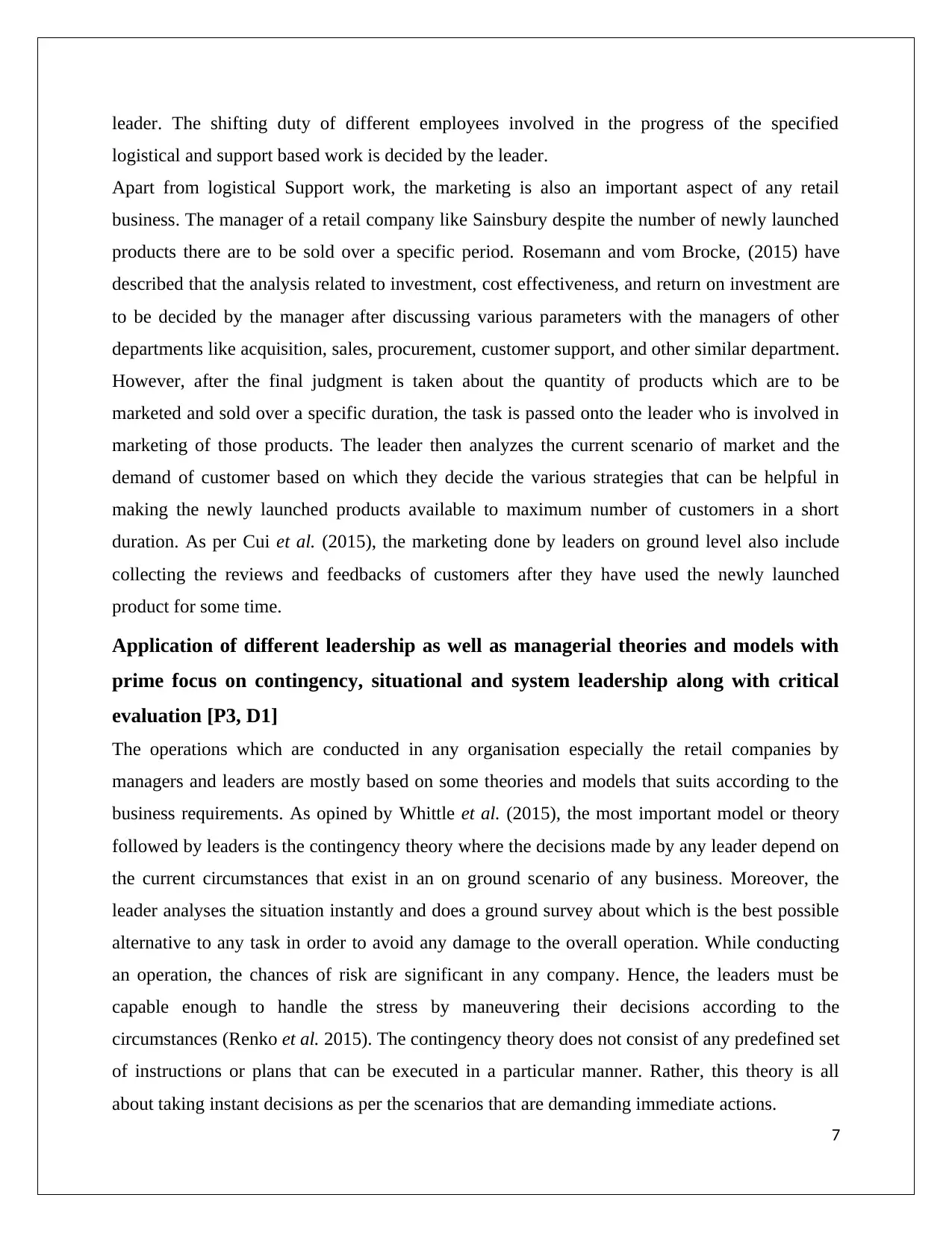
leader. The shifting duty of different employees involved in the progress of the specified
logistical and support based work is decided by the leader.
Apart from logistical Support work, the marketing is also an important aspect of any retail
business. The manager of a retail company like Sainsbury despite the number of newly launched
products there are to be sold over a specific period. Rosemann and vom Brocke, (2015) have
described that the analysis related to investment, cost effectiveness, and return on investment are
to be decided by the manager after discussing various parameters with the managers of other
departments like acquisition, sales, procurement, customer support, and other similar department.
However, after the final judgment is taken about the quantity of products which are to be
marketed and sold over a specific duration, the task is passed onto the leader who is involved in
marketing of those products. The leader then analyzes the current scenario of market and the
demand of customer based on which they decide the various strategies that can be helpful in
making the newly launched products available to maximum number of customers in a short
duration. As per Cui et al. (2015), the marketing done by leaders on ground level also include
collecting the reviews and feedbacks of customers after they have used the newly launched
product for some time.
Application of different leadership as well as managerial theories and models with
prime focus on contingency, situational and system leadership along with critical
evaluation [P3, D1]
The operations which are conducted in any organisation especially the retail companies by
managers and leaders are mostly based on some theories and models that suits according to the
business requirements. As opined by Whittle et al. (2015), the most important model or theory
followed by leaders is the contingency theory where the decisions made by any leader depend on
the current circumstances that exist in an on ground scenario of any business. Moreover, the
leader analyses the situation instantly and does a ground survey about which is the best possible
alternative to any task in order to avoid any damage to the overall operation. While conducting
an operation, the chances of risk are significant in any company. Hence, the leaders must be
capable enough to handle the stress by maneuvering their decisions according to the
circumstances (Renko et al. 2015). The contingency theory does not consist of any predefined set
of instructions or plans that can be executed in a particular manner. Rather, this theory is all
about taking instant decisions as per the scenarios that are demanding immediate actions.
7
logistical and support based work is decided by the leader.
Apart from logistical Support work, the marketing is also an important aspect of any retail
business. The manager of a retail company like Sainsbury despite the number of newly launched
products there are to be sold over a specific period. Rosemann and vom Brocke, (2015) have
described that the analysis related to investment, cost effectiveness, and return on investment are
to be decided by the manager after discussing various parameters with the managers of other
departments like acquisition, sales, procurement, customer support, and other similar department.
However, after the final judgment is taken about the quantity of products which are to be
marketed and sold over a specific duration, the task is passed onto the leader who is involved in
marketing of those products. The leader then analyzes the current scenario of market and the
demand of customer based on which they decide the various strategies that can be helpful in
making the newly launched products available to maximum number of customers in a short
duration. As per Cui et al. (2015), the marketing done by leaders on ground level also include
collecting the reviews and feedbacks of customers after they have used the newly launched
product for some time.
Application of different leadership as well as managerial theories and models with
prime focus on contingency, situational and system leadership along with critical
evaluation [P3, D1]
The operations which are conducted in any organisation especially the retail companies by
managers and leaders are mostly based on some theories and models that suits according to the
business requirements. As opined by Whittle et al. (2015), the most important model or theory
followed by leaders is the contingency theory where the decisions made by any leader depend on
the current circumstances that exist in an on ground scenario of any business. Moreover, the
leader analyses the situation instantly and does a ground survey about which is the best possible
alternative to any task in order to avoid any damage to the overall operation. While conducting
an operation, the chances of risk are significant in any company. Hence, the leaders must be
capable enough to handle the stress by maneuvering their decisions according to the
circumstances (Renko et al. 2015). The contingency theory does not consist of any predefined set
of instructions or plans that can be executed in a particular manner. Rather, this theory is all
about taking instant decisions as per the scenarios that are demanding immediate actions.
7
Paraphrase This Document
Need a fresh take? Get an instant paraphrase of this document with our AI Paraphraser
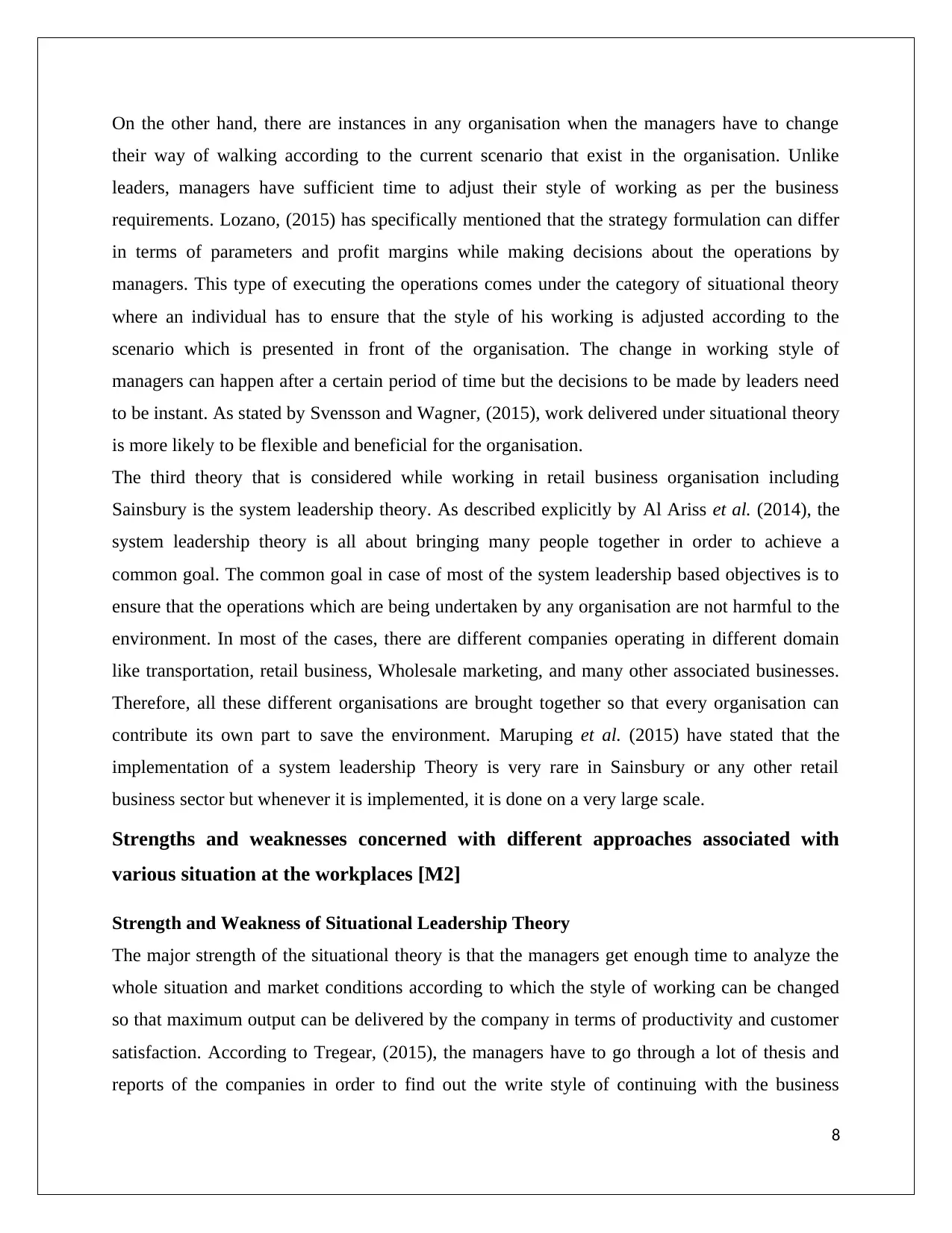
On the other hand, there are instances in any organisation when the managers have to change
their way of walking according to the current scenario that exist in the organisation. Unlike
leaders, managers have sufficient time to adjust their style of working as per the business
requirements. Lozano, (2015) has specifically mentioned that the strategy formulation can differ
in terms of parameters and profit margins while making decisions about the operations by
managers. This type of executing the operations comes under the category of situational theory
where an individual has to ensure that the style of his working is adjusted according to the
scenario which is presented in front of the organisation. The change in working style of
managers can happen after a certain period of time but the decisions to be made by leaders need
to be instant. As stated by Svensson and Wagner, (2015), work delivered under situational theory
is more likely to be flexible and beneficial for the organisation.
The third theory that is considered while working in retail business organisation including
Sainsbury is the system leadership theory. As described explicitly by Al Ariss et al. (2014), the
system leadership theory is all about bringing many people together in order to achieve a
common goal. The common goal in case of most of the system leadership based objectives is to
ensure that the operations which are being undertaken by any organisation are not harmful to the
environment. In most of the cases, there are different companies operating in different domain
like transportation, retail business, Wholesale marketing, and many other associated businesses.
Therefore, all these different organisations are brought together so that every organisation can
contribute its own part to save the environment. Maruping et al. (2015) have stated that the
implementation of a system leadership Theory is very rare in Sainsbury or any other retail
business sector but whenever it is implemented, it is done on a very large scale.
Strengths and weaknesses concerned with different approaches associated with
various situation at the workplaces [M2]
Strength and Weakness of Situational Leadership Theory
The major strength of the situational theory is that the managers get enough time to analyze the
whole situation and market conditions according to which the style of working can be changed
so that maximum output can be delivered by the company in terms of productivity and customer
satisfaction. According to Tregear, (2015), the managers have to go through a lot of thesis and
reports of the companies in order to find out the write style of continuing with the business
8
their way of walking according to the current scenario that exist in the organisation. Unlike
leaders, managers have sufficient time to adjust their style of working as per the business
requirements. Lozano, (2015) has specifically mentioned that the strategy formulation can differ
in terms of parameters and profit margins while making decisions about the operations by
managers. This type of executing the operations comes under the category of situational theory
where an individual has to ensure that the style of his working is adjusted according to the
scenario which is presented in front of the organisation. The change in working style of
managers can happen after a certain period of time but the decisions to be made by leaders need
to be instant. As stated by Svensson and Wagner, (2015), work delivered under situational theory
is more likely to be flexible and beneficial for the organisation.
The third theory that is considered while working in retail business organisation including
Sainsbury is the system leadership theory. As described explicitly by Al Ariss et al. (2014), the
system leadership theory is all about bringing many people together in order to achieve a
common goal. The common goal in case of most of the system leadership based objectives is to
ensure that the operations which are being undertaken by any organisation are not harmful to the
environment. In most of the cases, there are different companies operating in different domain
like transportation, retail business, Wholesale marketing, and many other associated businesses.
Therefore, all these different organisations are brought together so that every organisation can
contribute its own part to save the environment. Maruping et al. (2015) have stated that the
implementation of a system leadership Theory is very rare in Sainsbury or any other retail
business sector but whenever it is implemented, it is done on a very large scale.
Strengths and weaknesses concerned with different approaches associated with
various situation at the workplaces [M2]
Strength and Weakness of Situational Leadership Theory
The major strength of the situational theory is that the managers get enough time to analyze the
whole situation and market conditions according to which the style of working can be changed
so that maximum output can be delivered by the company in terms of productivity and customer
satisfaction. According to Tregear, (2015), the managers have to go through a lot of thesis and
reports of the companies in order to find out the write style of continuing with the business
8
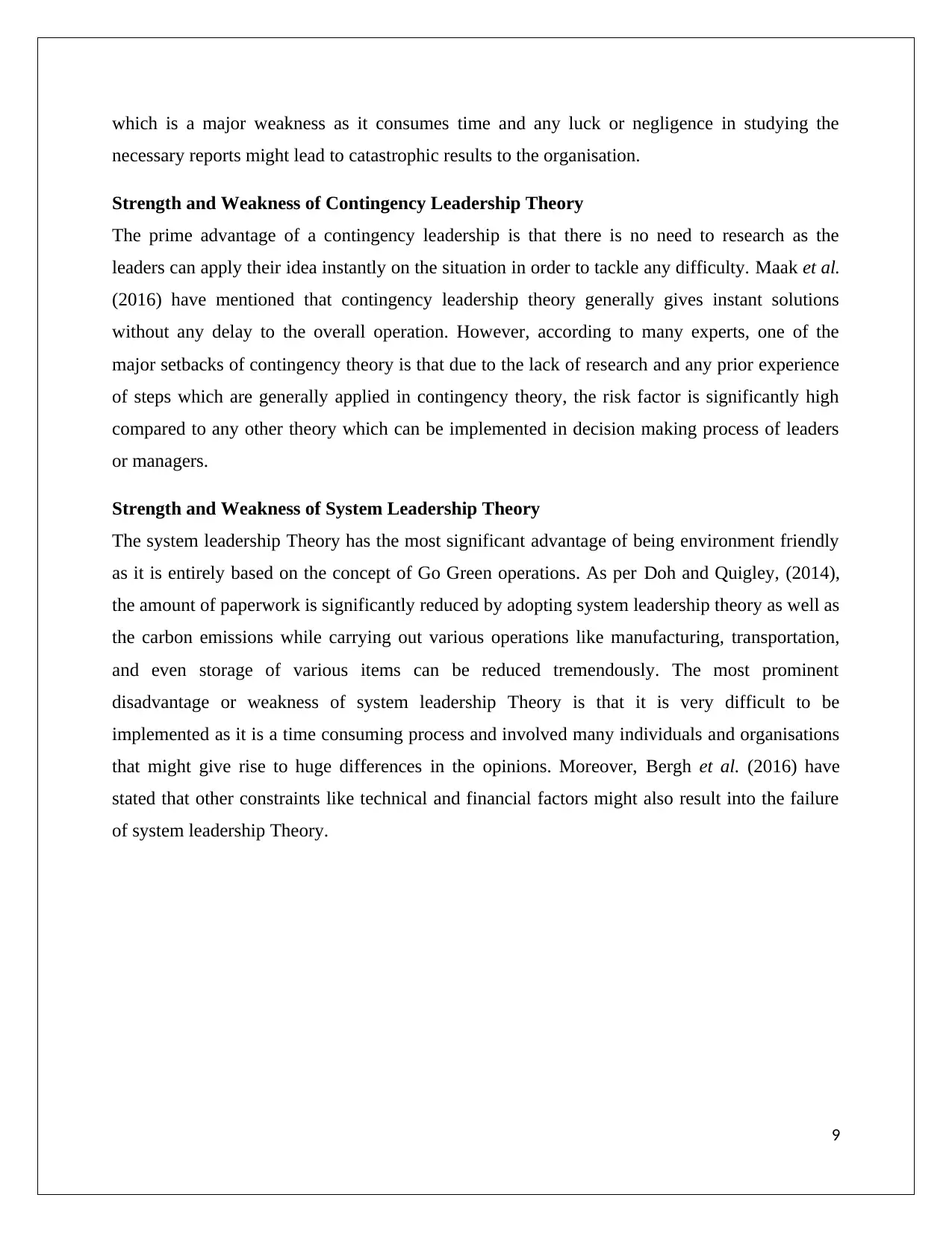
which is a major weakness as it consumes time and any luck or negligence in studying the
necessary reports might lead to catastrophic results to the organisation.
Strength and Weakness of Contingency Leadership Theory
The prime advantage of a contingency leadership is that there is no need to research as the
leaders can apply their idea instantly on the situation in order to tackle any difficulty. Maak et al.
(2016) have mentioned that contingency leadership theory generally gives instant solutions
without any delay to the overall operation. However, according to many experts, one of the
major setbacks of contingency theory is that due to the lack of research and any prior experience
of steps which are generally applied in contingency theory, the risk factor is significantly high
compared to any other theory which can be implemented in decision making process of leaders
or managers.
Strength and Weakness of System Leadership Theory
The system leadership Theory has the most significant advantage of being environment friendly
as it is entirely based on the concept of Go Green operations. As per Doh and Quigley, (2014),
the amount of paperwork is significantly reduced by adopting system leadership theory as well as
the carbon emissions while carrying out various operations like manufacturing, transportation,
and even storage of various items can be reduced tremendously. The most prominent
disadvantage or weakness of system leadership Theory is that it is very difficult to be
implemented as it is a time consuming process and involved many individuals and organisations
that might give rise to huge differences in the opinions. Moreover, Bergh et al. (2016) have
stated that other constraints like technical and financial factors might also result into the failure
of system leadership Theory.
9
necessary reports might lead to catastrophic results to the organisation.
Strength and Weakness of Contingency Leadership Theory
The prime advantage of a contingency leadership is that there is no need to research as the
leaders can apply their idea instantly on the situation in order to tackle any difficulty. Maak et al.
(2016) have mentioned that contingency leadership theory generally gives instant solutions
without any delay to the overall operation. However, according to many experts, one of the
major setbacks of contingency theory is that due to the lack of research and any prior experience
of steps which are generally applied in contingency theory, the risk factor is significantly high
compared to any other theory which can be implemented in decision making process of leaders
or managers.
Strength and Weakness of System Leadership Theory
The system leadership Theory has the most significant advantage of being environment friendly
as it is entirely based on the concept of Go Green operations. As per Doh and Quigley, (2014),
the amount of paperwork is significantly reduced by adopting system leadership theory as well as
the carbon emissions while carrying out various operations like manufacturing, transportation,
and even storage of various items can be reduced tremendously. The most prominent
disadvantage or weakness of system leadership Theory is that it is very difficult to be
implemented as it is a time consuming process and involved many individuals and organisations
that might give rise to huge differences in the opinions. Moreover, Bergh et al. (2016) have
stated that other constraints like technical and financial factors might also result into the failure
of system leadership Theory.
9
⊘ This is a preview!⊘
Do you want full access?
Subscribe today to unlock all pages.

Trusted by 1+ million students worldwide
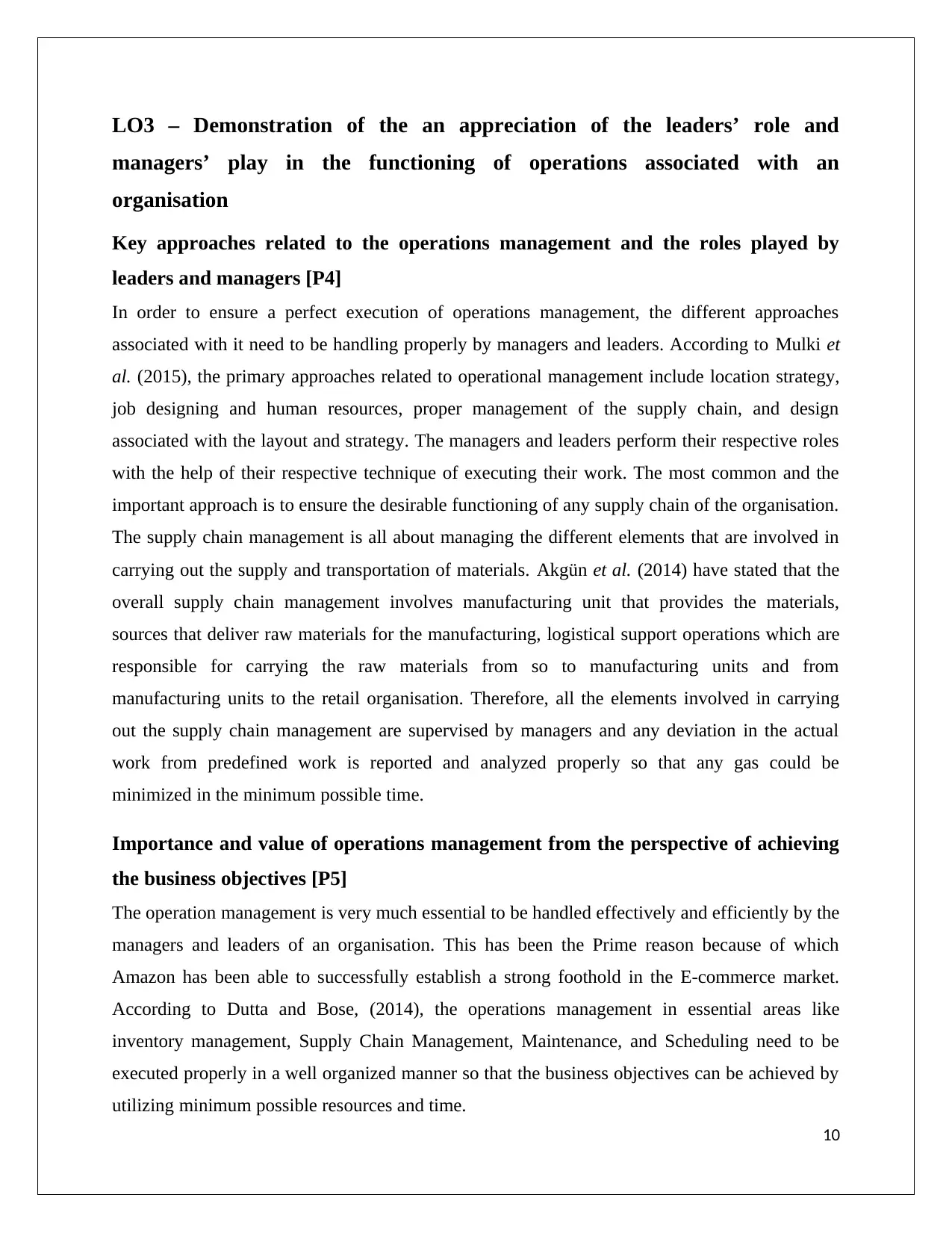
LO3 – Demonstration of the an appreciation of the leaders’ role and
managers’ play in the functioning of operations associated with an
organisation
Key approaches related to the operations management and the roles played by
leaders and managers [P4]
In order to ensure a perfect execution of operations management, the different approaches
associated with it need to be handling properly by managers and leaders. According to Mulki et
al. (2015), the primary approaches related to operational management include location strategy,
job designing and human resources, proper management of the supply chain, and design
associated with the layout and strategy. The managers and leaders perform their respective roles
with the help of their respective technique of executing their work. The most common and the
important approach is to ensure the desirable functioning of any supply chain of the organisation.
The supply chain management is all about managing the different elements that are involved in
carrying out the supply and transportation of materials. Akgün et al. (2014) have stated that the
overall supply chain management involves manufacturing unit that provides the materials,
sources that deliver raw materials for the manufacturing, logistical support operations which are
responsible for carrying the raw materials from so to manufacturing units and from
manufacturing units to the retail organisation. Therefore, all the elements involved in carrying
out the supply chain management are supervised by managers and any deviation in the actual
work from predefined work is reported and analyzed properly so that any gas could be
minimized in the minimum possible time.
Importance and value of operations management from the perspective of achieving
the business objectives [P5]
The operation management is very much essential to be handled effectively and efficiently by the
managers and leaders of an organisation. This has been the Prime reason because of which
Amazon has been able to successfully establish a strong foothold in the E-commerce market.
According to Dutta and Bose, (2014), the operations management in essential areas like
inventory management, Supply Chain Management, Maintenance, and Scheduling need to be
executed properly in a well organized manner so that the business objectives can be achieved by
utilizing minimum possible resources and time.
10
managers’ play in the functioning of operations associated with an
organisation
Key approaches related to the operations management and the roles played by
leaders and managers [P4]
In order to ensure a perfect execution of operations management, the different approaches
associated with it need to be handling properly by managers and leaders. According to Mulki et
al. (2015), the primary approaches related to operational management include location strategy,
job designing and human resources, proper management of the supply chain, and design
associated with the layout and strategy. The managers and leaders perform their respective roles
with the help of their respective technique of executing their work. The most common and the
important approach is to ensure the desirable functioning of any supply chain of the organisation.
The supply chain management is all about managing the different elements that are involved in
carrying out the supply and transportation of materials. Akgün et al. (2014) have stated that the
overall supply chain management involves manufacturing unit that provides the materials,
sources that deliver raw materials for the manufacturing, logistical support operations which are
responsible for carrying the raw materials from so to manufacturing units and from
manufacturing units to the retail organisation. Therefore, all the elements involved in carrying
out the supply chain management are supervised by managers and any deviation in the actual
work from predefined work is reported and analyzed properly so that any gas could be
minimized in the minimum possible time.
Importance and value of operations management from the perspective of achieving
the business objectives [P5]
The operation management is very much essential to be handled effectively and efficiently by the
managers and leaders of an organisation. This has been the Prime reason because of which
Amazon has been able to successfully establish a strong foothold in the E-commerce market.
According to Dutta and Bose, (2014), the operations management in essential areas like
inventory management, Supply Chain Management, Maintenance, and Scheduling need to be
executed properly in a well organized manner so that the business objectives can be achieved by
utilizing minimum possible resources and time.
10
Paraphrase This Document
Need a fresh take? Get an instant paraphrase of this document with our AI Paraphraser
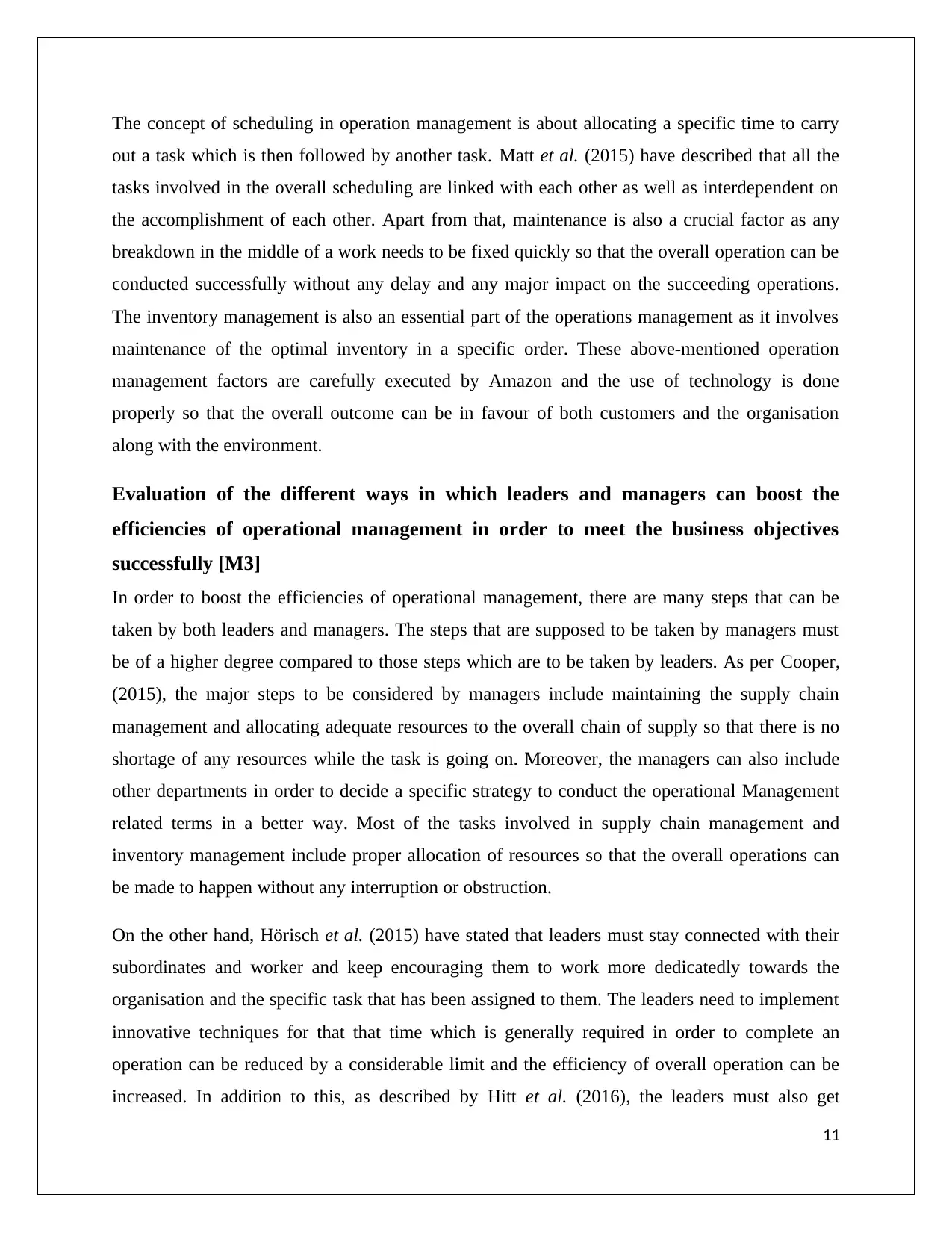
The concept of scheduling in operation management is about allocating a specific time to carry
out a task which is then followed by another task. Matt et al. (2015) have described that all the
tasks involved in the overall scheduling are linked with each other as well as interdependent on
the accomplishment of each other. Apart from that, maintenance is also a crucial factor as any
breakdown in the middle of a work needs to be fixed quickly so that the overall operation can be
conducted successfully without any delay and any major impact on the succeeding operations.
The inventory management is also an essential part of the operations management as it involves
maintenance of the optimal inventory in a specific order. These above-mentioned operation
management factors are carefully executed by Amazon and the use of technology is done
properly so that the overall outcome can be in favour of both customers and the organisation
along with the environment.
Evaluation of the different ways in which leaders and managers can boost the
efficiencies of operational management in order to meet the business objectives
successfully [M3]
In order to boost the efficiencies of operational management, there are many steps that can be
taken by both leaders and managers. The steps that are supposed to be taken by managers must
be of a higher degree compared to those steps which are to be taken by leaders. As per Cooper,
(2015), the major steps to be considered by managers include maintaining the supply chain
management and allocating adequate resources to the overall chain of supply so that there is no
shortage of any resources while the task is going on. Moreover, the managers can also include
other departments in order to decide a specific strategy to conduct the operational Management
related terms in a better way. Most of the tasks involved in supply chain management and
inventory management include proper allocation of resources so that the overall operations can
be made to happen without any interruption or obstruction.
On the other hand, Hörisch et al. (2015) have stated that leaders must stay connected with their
subordinates and worker and keep encouraging them to work more dedicatedly towards the
organisation and the specific task that has been assigned to them. The leaders need to implement
innovative techniques for that that time which is generally required in order to complete an
operation can be reduced by a considerable limit and the efficiency of overall operation can be
increased. In addition to this, as described by Hitt et al. (2016), the leaders must also get
11
out a task which is then followed by another task. Matt et al. (2015) have described that all the
tasks involved in the overall scheduling are linked with each other as well as interdependent on
the accomplishment of each other. Apart from that, maintenance is also a crucial factor as any
breakdown in the middle of a work needs to be fixed quickly so that the overall operation can be
conducted successfully without any delay and any major impact on the succeeding operations.
The inventory management is also an essential part of the operations management as it involves
maintenance of the optimal inventory in a specific order. These above-mentioned operation
management factors are carefully executed by Amazon and the use of technology is done
properly so that the overall outcome can be in favour of both customers and the organisation
along with the environment.
Evaluation of the different ways in which leaders and managers can boost the
efficiencies of operational management in order to meet the business objectives
successfully [M3]
In order to boost the efficiencies of operational management, there are many steps that can be
taken by both leaders and managers. The steps that are supposed to be taken by managers must
be of a higher degree compared to those steps which are to be taken by leaders. As per Cooper,
(2015), the major steps to be considered by managers include maintaining the supply chain
management and allocating adequate resources to the overall chain of supply so that there is no
shortage of any resources while the task is going on. Moreover, the managers can also include
other departments in order to decide a specific strategy to conduct the operational Management
related terms in a better way. Most of the tasks involved in supply chain management and
inventory management include proper allocation of resources so that the overall operations can
be made to happen without any interruption or obstruction.
On the other hand, Hörisch et al. (2015) have stated that leaders must stay connected with their
subordinates and worker and keep encouraging them to work more dedicatedly towards the
organisation and the specific task that has been assigned to them. The leaders need to implement
innovative techniques for that that time which is generally required in order to complete an
operation can be reduced by a considerable limit and the efficiency of overall operation can be
increased. In addition to this, as described by Hitt et al. (2016), the leaders must also get
11
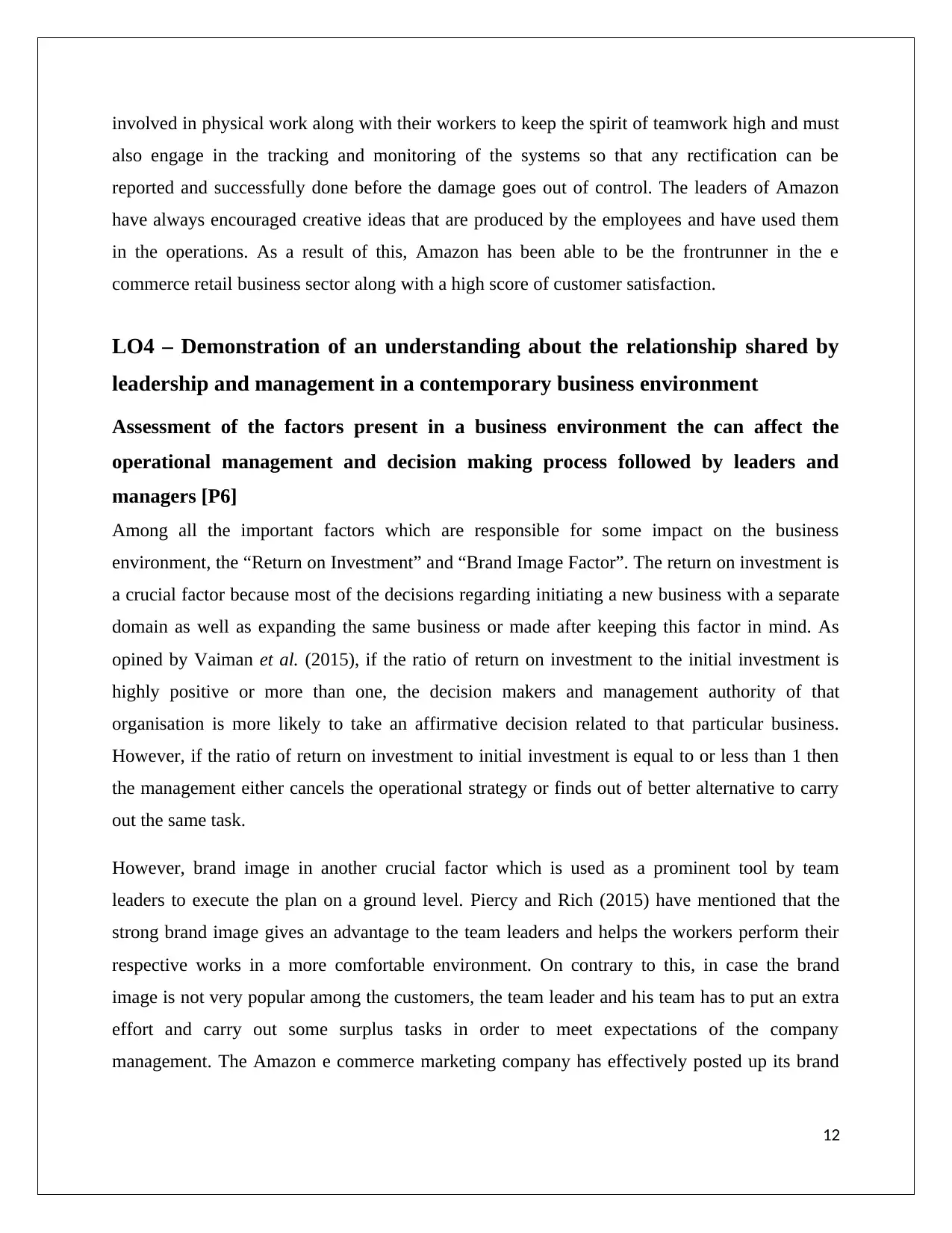
involved in physical work along with their workers to keep the spirit of teamwork high and must
also engage in the tracking and monitoring of the systems so that any rectification can be
reported and successfully done before the damage goes out of control. The leaders of Amazon
have always encouraged creative ideas that are produced by the employees and have used them
in the operations. As a result of this, Amazon has been able to be the frontrunner in the e
commerce retail business sector along with a high score of customer satisfaction.
LO4 – Demonstration of an understanding about the relationship shared by
leadership and management in a contemporary business environment
Assessment of the factors present in a business environment the can affect the
operational management and decision making process followed by leaders and
managers [P6]
Among all the important factors which are responsible for some impact on the business
environment, the “Return on Investment” and “Brand Image Factor”. The return on investment is
a crucial factor because most of the decisions regarding initiating a new business with a separate
domain as well as expanding the same business or made after keeping this factor in mind. As
opined by Vaiman et al. (2015), if the ratio of return on investment to the initial investment is
highly positive or more than one, the decision makers and management authority of that
organisation is more likely to take an affirmative decision related to that particular business.
However, if the ratio of return on investment to initial investment is equal to or less than 1 then
the management either cancels the operational strategy or finds out of better alternative to carry
out the same task.
However, brand image in another crucial factor which is used as a prominent tool by team
leaders to execute the plan on a ground level. Piercy and Rich (2015) have mentioned that the
strong brand image gives an advantage to the team leaders and helps the workers perform their
respective works in a more comfortable environment. On contrary to this, in case the brand
image is not very popular among the customers, the team leader and his team has to put an extra
effort and carry out some surplus tasks in order to meet expectations of the company
management. The Amazon e commerce marketing company has effectively posted up its brand
12
also engage in the tracking and monitoring of the systems so that any rectification can be
reported and successfully done before the damage goes out of control. The leaders of Amazon
have always encouraged creative ideas that are produced by the employees and have used them
in the operations. As a result of this, Amazon has been able to be the frontrunner in the e
commerce retail business sector along with a high score of customer satisfaction.
LO4 – Demonstration of an understanding about the relationship shared by
leadership and management in a contemporary business environment
Assessment of the factors present in a business environment the can affect the
operational management and decision making process followed by leaders and
managers [P6]
Among all the important factors which are responsible for some impact on the business
environment, the “Return on Investment” and “Brand Image Factor”. The return on investment is
a crucial factor because most of the decisions regarding initiating a new business with a separate
domain as well as expanding the same business or made after keeping this factor in mind. As
opined by Vaiman et al. (2015), if the ratio of return on investment to the initial investment is
highly positive or more than one, the decision makers and management authority of that
organisation is more likely to take an affirmative decision related to that particular business.
However, if the ratio of return on investment to initial investment is equal to or less than 1 then
the management either cancels the operational strategy or finds out of better alternative to carry
out the same task.
However, brand image in another crucial factor which is used as a prominent tool by team
leaders to execute the plan on a ground level. Piercy and Rich (2015) have mentioned that the
strong brand image gives an advantage to the team leaders and helps the workers perform their
respective works in a more comfortable environment. On contrary to this, in case the brand
image is not very popular among the customers, the team leader and his team has to put an extra
effort and carry out some surplus tasks in order to meet expectations of the company
management. The Amazon e commerce marketing company has effectively posted up its brand
12
⊘ This is a preview!⊘
Do you want full access?
Subscribe today to unlock all pages.

Trusted by 1+ million students worldwide
1 out of 18
Related Documents
Your All-in-One AI-Powered Toolkit for Academic Success.
+13062052269
info@desklib.com
Available 24*7 on WhatsApp / Email
![[object Object]](/_next/static/media/star-bottom.7253800d.svg)
Unlock your academic potential
Copyright © 2020–2025 A2Z Services. All Rights Reserved. Developed and managed by ZUCOL.



